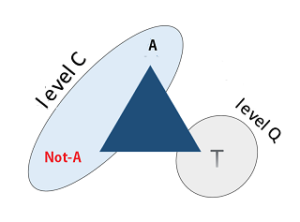
The unit and the included third
Polarization, dualism and binary ontology (being is and non-being is not) are so present in the human relations of the present that it is difficult to think of a third hypothesis, but quantum physics has already described it and more than its effect ghostly (Einstein, Podolski and Rosen called it and this effect was then known as EPR), there is an effect in real life, quantum computers are coming, and it would be good for philosophy to wake up from its rational sleep (which has no liquid) or solid), and awakened to a new reality.
are so present in the human relations of the present that it is difficult to think of a third hypothesis, but quantum physics has already described it and more than its effect ghostly (Einstein, Podolski and Rosen called it and this effect was then known as EPR), there is an effect in real life, quantum computers are coming, and it would be good for philosophy to wake up from its rational sleep (which has no liquid) or solid), and awakened to a new reality.
The classic Aristotelian logic justifies the exclusion of a third term and it prevailed until recently it is it that is at the base of fundamentalist, racist and scientist philosophies, which also underlie the principle of the excluded third that separates “good” from “evil” (the manichaeism) according to this logic:
- Axiom of Identity: “A is A”
- Axiom of Non-Contradiction: “A is not non-A”
- Axiom of the Excluded Third: “there is no third term T that is both A and non-A”.
The logic of physics and also of scientism (it is not true science) establishes this, however the contradiction between identity and non-identity is observed by quantum physics, being called the principle of quantum superposition, whose effect was studied within physics called “Tunneling” observing particles that transpose the classically prohibited state.
The logic of the excluded third was first enunciated by the philosopher Stéphane Lupascu (1900-1988), where there is a third term T that is both A and non-A, its axiomatic formalism predicts that it coexists with the dynamics of heterogeneity (to which it belongs living matter and the complex universe), with that of homogeneity (which governs macroscopic physical matter), and thus there are different “levels of reality”, of course all scientism is in check.
This new logic (level Q) does not abolish the Aristotelian logic of “yes” and “no” (level C), since only two terms are not considered, but in addition to these a third (T) (see figure). The first to establish the different levels of reality was Barsarab Nicolescu (1942-), he described a change from one level of reality to another with laws, new logics and concepts specific to each level, and thus established the concept of transdisciplinarity, which also encompasses complexity.
This logic admits three pillars for transdisciplinarity:
- Different Levels of Reality
- Third Term Logic Included 6.
- Complexity
So it must be admitted, for example, that between two people there is a third level of reality in which none of the personal logics are subjected and can and must have sufficient openness to a new reality, from which a new horizon and a new perception emerges. of the truth.
It is not a matter of relativism where the truth does not exist, but rather a state of rigorous equilibrium, accepting that between the poles of a contradiction, there is a semi-actualization and an equal semi-potentialization for both poles, this is state T.









